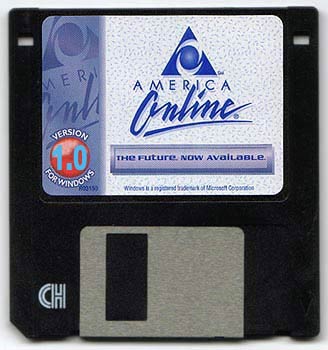
Once upon a time, our parents didn't have a clue what we were doing online. The internet was a new and exciting place, and it seemed like a safe and inpenetrable fortress of unsupervised mischief. Mind you, this was years before Chris Hansen was popping in to offer you a seat while the decoy internet teen went to go check on the hot tub. There was no catching of predators, no online policing, just pure, unadulterated dangerous fun.
If anything, our parents were more concerned with our tying up the phone lines than our online whereabouts. Sure, we may have been making under-the-table investments with Nigerian princes, but our parents were solely worried about the busy signal clogging our line. Back in the day, there was no wireless or high speed internet connections, there was a little phone jack that shared a common line with our home phones. In a time before universal cell phone ownership, this was a pretty serious inconvenience. Not to mention how annoying that modem sound was when you picked up the phone. Ouch.
When children of the 90s first got in-home internet access, it was a novel and exciting concept. Finally, a relatively captive audience with whom to share our innermost thoughts, dreams, and anonymous flirtations. Once we could actually forge a connection, that is. I'd sit for scores of minutes at a time, waiting impatiently for that little running AOL man to enter his successive phase of connectedness. Words like "modem failure" and "inability to connect" haunted us, forcing us to redial and redial until finally we could enter our glorious online community.

At our house, there were three potential modem phone numbers with which to reach the internet, and we'd frantically alternate between our options, forever seeking a signal. It's remarkable to think that just a decade earlier, we were content to wait five minutes to catch even the briefest glimpse of the internet. Nowadays, if a website takes more than three seconds to load we're all about one step away from tossing the laptop out the window. Back then, though, these were different times. More patient times. And of course, more salacious.
No sooner than we'd heard that familiar robotically enthusiastic declaration "You've Got Mail!", we'd be clamoring to reach our favorite chat rooms. As AOL was the premier internet service of the 90s, a good chunk of the online population could be found roaming these virtual spaces. It was a novel concept for the time: you could actually communicate with many people at once! People you didn't know! People who we should trust indefinitely to be telling the truth, the absolute truth, and nothing but the truth!

So help us God, this was probably not the case. Judging how things usually went our own end, it's doubtable that these new virtual pals were honest about any element of their existence other than that they were currently connected to the internet. The original chat rooms were popular online pickup scenes, the equivalent of an internet singles bar. Only, truth be told, all the people in those rooms were probably either under the age of 12 or over the age of 50.
While today a notion like that might raise a red flag or two, these things were chalked up to good, clean fun back then. Well, er, sort of clean. Children delighted in their ability to fool others, though looking back it's unlikely that my friends and I fooled anyone with our fifth grade writing skills and general misunderstanding of innuendos.
From the moment a person asked, "A/S/L", you knew it was on. That is, imploring his chatroommates to give their age, sex, and location. I don't know about you, but this was a great source of fun for my pals and I as children. In one room we could be exotic 18-year old Brazilian twins working to get our modeling careers off the ground while in the next we could easily slip into the guise of a mysterious lonelyhearts Spanish exchange student seeking a nice middle aged office drone to. The possibilities were truly endless.

Sometimes we may have outed ourselves as the 12/Fs we really were, but in general the idea was to fool others into believing the bull we were serving up. I imagine parents everywhere would have been pretty uneasy to find that their young children were being approached online with the request to "cyber", but again, these were different times. Very few people had considered the notion of troubling internet connections, we were too enthralled by its exciting possibilities to see any danger in letting children loose into chatrooms with a slew of card-carrying NAMBLA members and known sex offenders.
In our innocence, though, we were too giddy to be bothered by these facts. These were the days before MySpace, Facebook, or online dating, so people everywhere used this free market chatroom environment to make connections. Users formed full-fledged online relationships with people they had never even met. Sure, in real life you may have been a Dungeons and Dragons playing loner with duct-taped glasses, but online you could be the suave AOL romeo you'd always dreamed of being. Until your potential mate requested a picture, of course. Photographic evidence is a bitch.

The original AOL was a kid's paradise. It's going date us immensely when we someday tell our children of plugging a common search term in a search engine and having zero results, but we'll know that we were the true online pioneers. We knew the thrill of navigating the unknown wildernesses of the internet before firewalls and parental controls and the like neutralized the treacherous terrain. Sure, we may have talked to a pedophile or two, but we lived, dammit. We lived. Well, vicariously through our internet alteregos. But you know what I mean.






0 comments:
Post a Comment